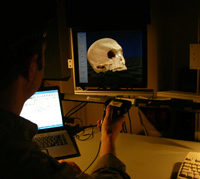Dynallax: Dynamic Parallax Barrier Autostereoscopic Display
January 1st, 2006 - Ongoing
Categories: Devices, MS / PhD Thesis, Visualization, VR

About
Parallax barrier strip autostereoscopic virtual reality displays such as Varrier™ have been constructed by placing a barrier of lines in front of an LCD display device. Together with a head tracking system and associated software to interleave portions of left and right eye images in appropriate positions on the display, an autostereo effect is achieved that can be quite compelling. In the past, the barrier was a static component. While easy to construct, a static barrier imposes certain limitations on the system.
Substituting a dynamic parallax barrier for the static barrier frees the system from such limitations. Immediate benefits gained by a dynamic barrier are: extended viewing distance range, reduced color shifts, ability to adjust various barrier parameters easily such as period spacing, tilt angle, and duty cycle, and the ability to simply disable the barrier converting the system to a 2D display. By dynamically controlling the parallax barrier in real time, more than two eye channels can be produced, to accommodate two viewers and provide each viewer with an independent pair of stereo perspectives.
A prototype system called “Dynallax” exemplifies the qualities of a dynamic parallax barrier for autostereoscopic applications. This is a small single-panel prototype based on a stacked dual-LCD display, although it is scalable to larger displays. A complete hardware and software system is developed for generating a dynamic parallax barrier constructed from a dual-stacked LCD display, with the following advantages over static barrier displays such as Varrier: First, a tracked independent perspective two-viewer mode is supported. Second, the minimum view distance is extended in real time. Third, faster head motion is supported through a rapid steering of view channels. Results are shared with the scientific community through publication in journals and conference proceedings, as well as through the Ph.D. dissertation of the lead researcher, Tom Peterka.